Nine days ago I spent some time photographing some of our most abundant (for those readers who don’t like the word “common” applied to birds) songbirds at my favorite greasewood bush.
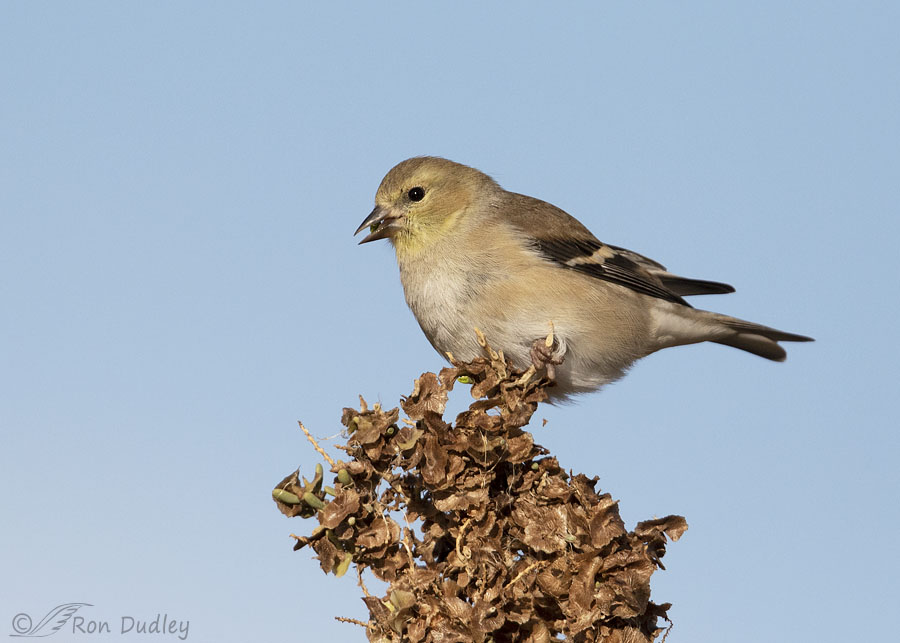
This time of year greasewood is a reliable source of large numbers of seeds for birds preparing for winter and on that particular morning at least three species were taking advantage of the bounty, including American Goldfinches. This time of year goldfinches aren’t in their more flamboyant breeding plumage but…
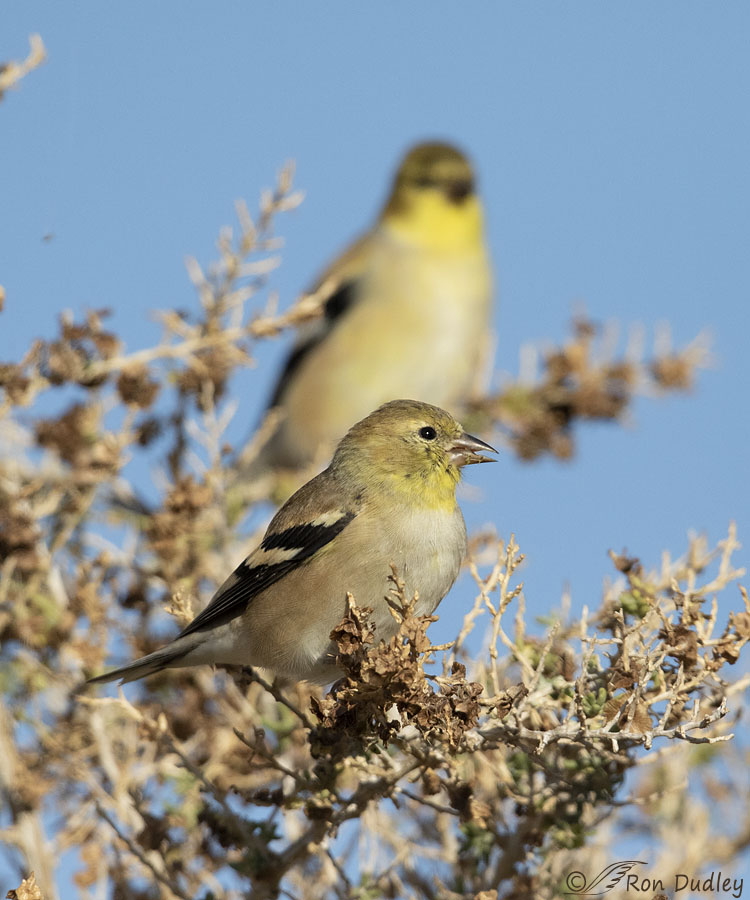
the adult males were more colorful. The goldfinches didn’t stay long but I enjoyed watching their feeding activities.
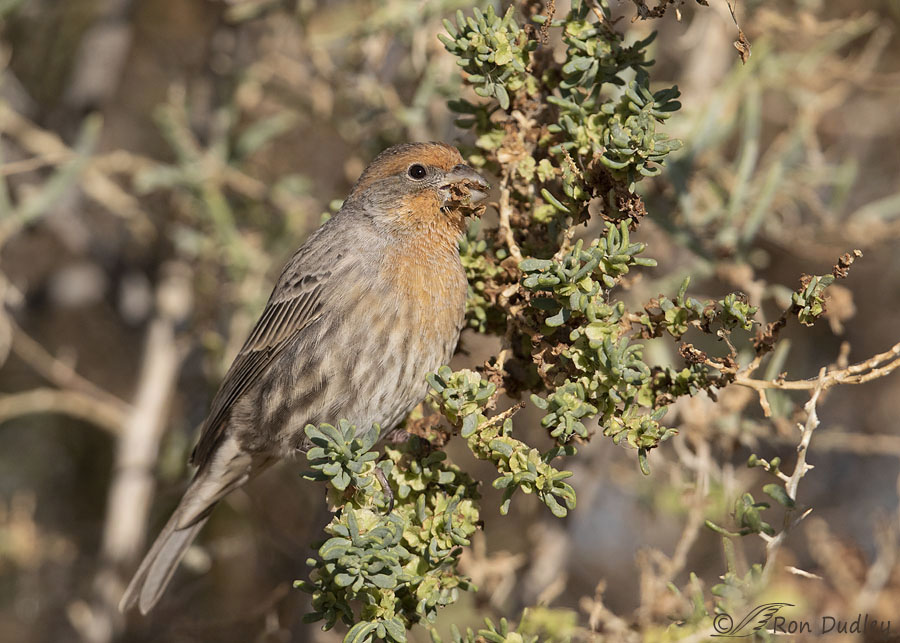
House Finches were the most abundant species at the greasewood. In most males of this species the predominant bright color is red and that’s the color I usually see. But in this species that color is determined by diet and the bright color of this male was orange rather than red.
This bird is what is called an “orange variant”.
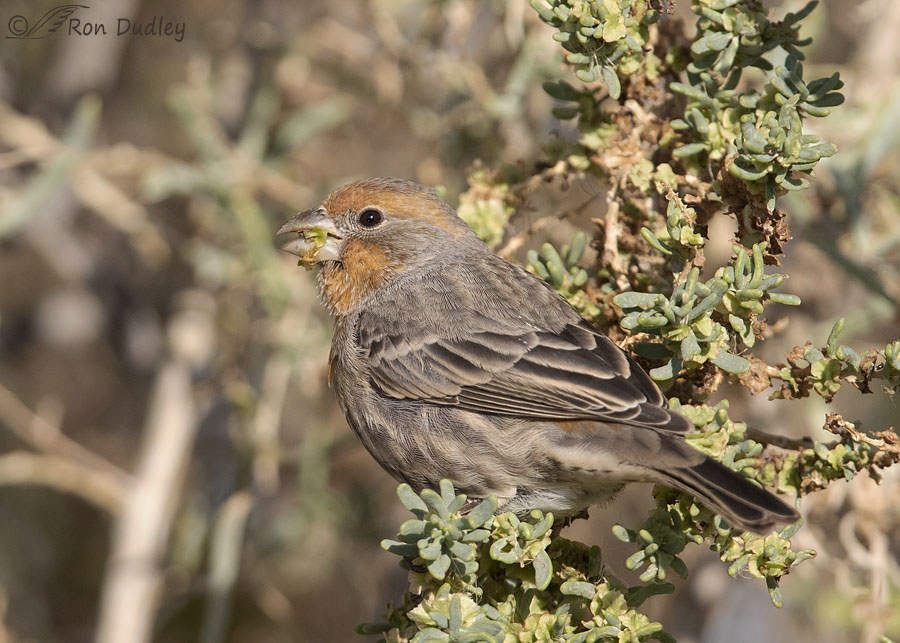
As he fed on the seeds he was pretty cooperative on a variety of perches.
Depending on their diet male House Finches can actually be red, orange or yellow. I’ve never photographed a yellow one and I don’t photograph orange ones very often so I was glad to get this guy in my viewfinder.
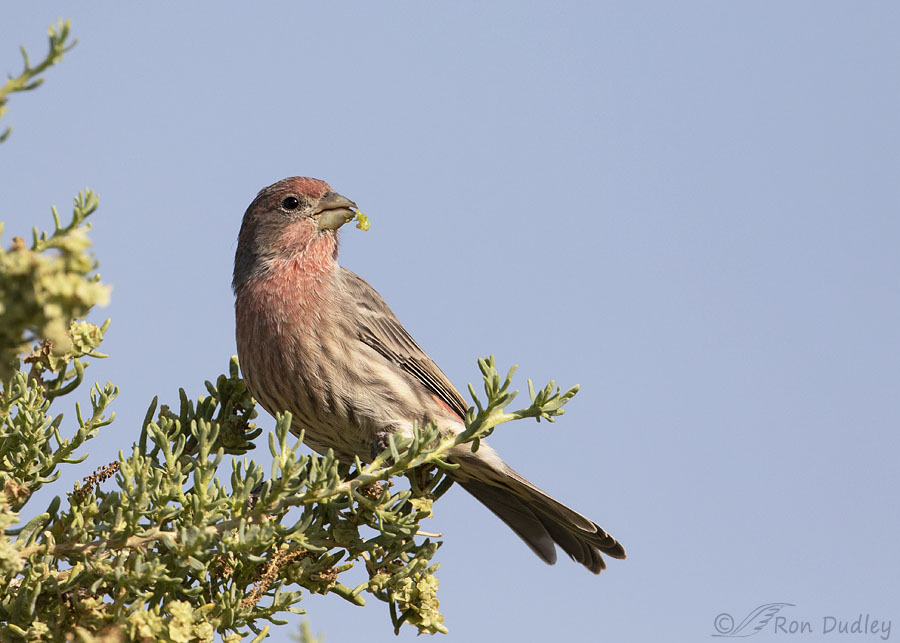
This time of year this shade of red (rather than orange) is the color I usually see in male House Finches. If you scroll back and forth between this photo and the previous one the color difference should become more obvious.
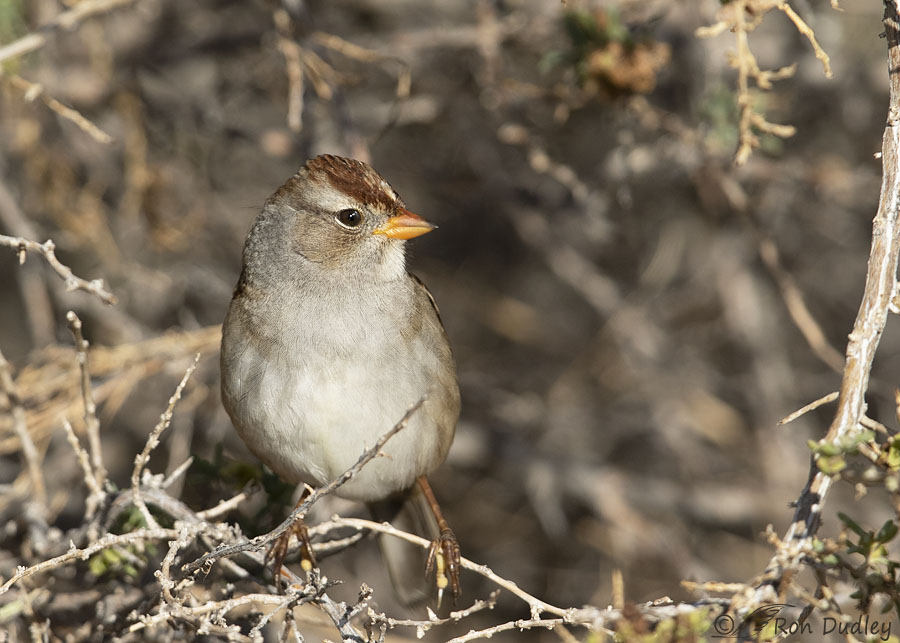
White-crowned Sparrows were the other abundant species in the greasewood. This immature white-crowned acted completely normally as ‘he’ fed on the seeds so at first I was unaware that he had a handicap.
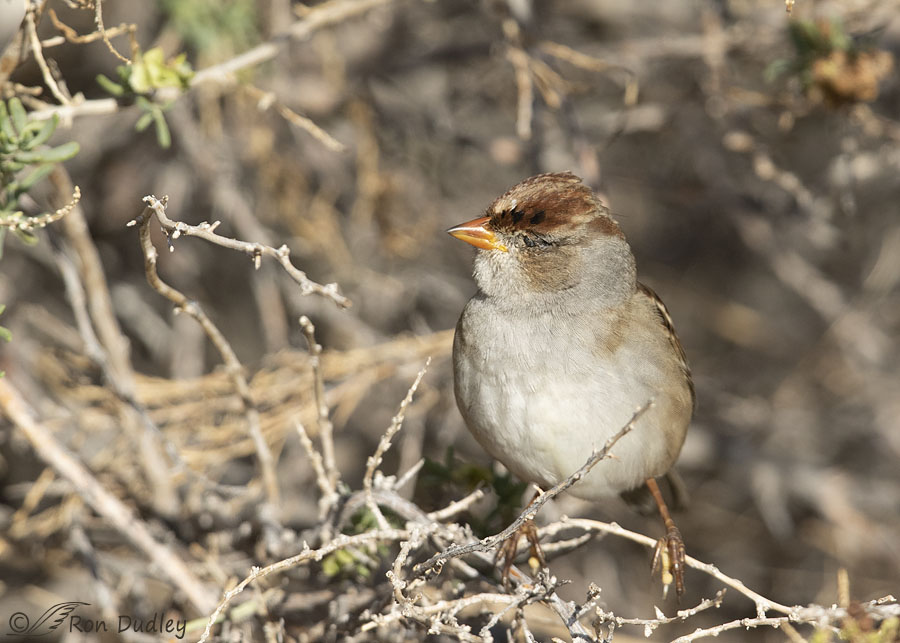
He was apparently blind in his left eye which he never once opened normally and completely. I don’t believe he could if he tried.
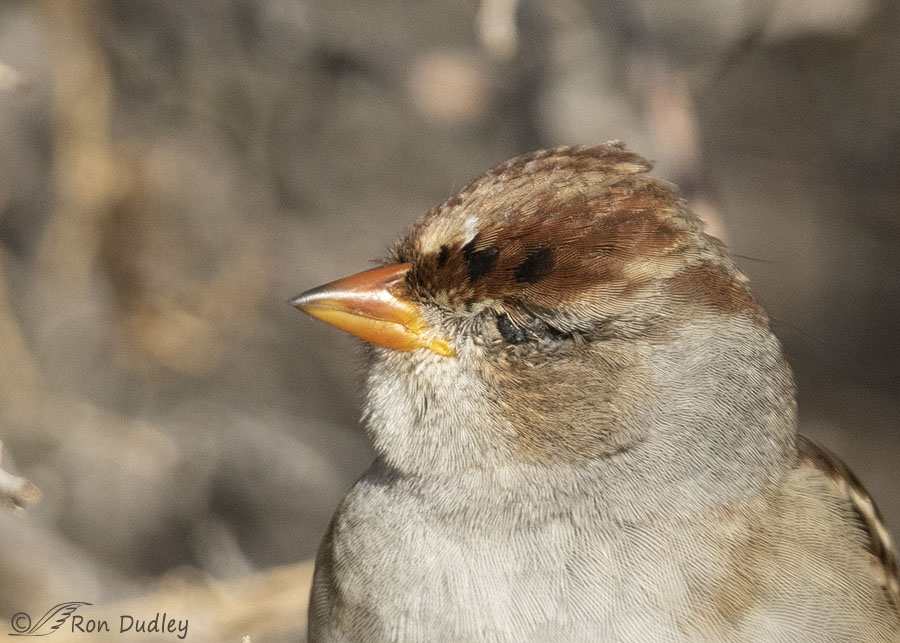
The blindness appeared to be due to an old injury that suggested to me that he’s adapting to his unfortunate circumstances.
I suspect that some of my readers would have preferred to be spared from seeing the last two images but I’m firmly of the opinion that glossing over or ignoring evidence of the challenges birds face doesn’t do them any favors. The more the general public is aware of the survival challenges faced by birds the more sympathetic they’re likely to be.
These days especially, birds need all the help they can get.
Ron
Note:
The chemistry involved with color variations in House Finches can be intimidating but for those wanting slightly more information here’s a pretty basic explanation from Audubon:
“A careful look at male House Finches at the feeder shows that, while most males show red feathering, some are decidedly more orange – and some even yellow. It turns out that House Finches acquire their coloration from pigments in the plant foods they eat. This is true for most birds with red-, orange-, or yellow-pigmented feathers. These tones each derive from a different organic pigment, known as carotenoids. So that yellow (or orange) male House Finch standing out from all the red ones? Well, his attire reflects something he ate – or didn’t eat.”


Thanks for your explanation of the orange variant house finch. This was news to me! Some googling led me to this article / study on caratenoid-based coloration .
This got me thinking about two orange variant scarlet tanagers I saw this summer and I wrote my own blog post about them in which I referenced your post. Thanks for inspiring me!
Pingback: Mysterious Orange Scarlet Tanagers – Being with Birds
…and we think our lives are tough. Thanks for the beautiful images.
Yup, its relative isn’t it, Fred. Thank you.
Thank you.
Your common/abundant birds are exotica to me. Very welcome exotica. And speaking for myself I am awed and amazed at the ‘handicaps’ that birds and animals seem to take in their stride.
Feather colouration is a fascinating rabbit hole that I am quite sure I could spend hours and hours exploring.
EC, I went down that rabbit hole for a little too long while I was writing this post. Which is why I gave a simplified version in today’s post.
If you had added Chickadees and Juncos that would pretty much cover the most numerous birds at our feeders.
Similar to Frances’s sister, at one time I was drinking a lot of carrot juice. People wondered if I was jaundiced. As far as I know House Finches don’t get their carotenoids from carrots.
I wish I had some of your chickadees and juncos at my feeder, Lyle. This morning all I had was dozens of House Sparrows and a single Eurasian Collared Dove.
“Entire books have been written on coloration.” Yes, as Dan Gleason stated. Zoos and Aviaries have to supplement the diets of captive birds to retain the brilliant feather colors, Flamingos would be white without food additives.
And there’s a lot of that info online, as I discovered when I was writing this post.
Color of bird feathers is not a simple subject. As you say, bright red, yellow and orange all come from plant pigments called carotenoids, and can only be obtained through the diet. Rusty reds, like the tail of a Red-tailed Hawk, are from a type of melanin the birds can make. But more than diet is important for the final color. Carotenoids are also used by the immune system. A bird’s whose health is stressed needs more carotenoids so less may be available for feather color. The red of the House Finch is a yellow pigment that the bird converts to a different carotenoid, resulting in red. But if only some of this can be converted, a blend of color is all that is available during the time of feather development resulting in the orange to yellow. Genetics and environment also are important. House Finches are more susceptible to these factors than many other birds. The color may change at the next molt depending upon all of these factors but whatever the color is it will remain until replaced by a new feather. This is a fascinating subject and entire books have been written on bird coloration. A search of the scientific literature will yield a very large number of articles on this subject. I might note that any of your readers in Hawaii will likely see only yellow House Finches because the carotenoid that is usually converted by House Finches here, is lacking in the diet of the birds there, thus the yellow pigment they consume there is all that is available for feather color. Fun stuff.
Fascinating. Thank you, Dan.
Yesterday I kept looking for my sparrows, white crowned and doves to come back after filling up the feeder. Finally noticed the neighbors cat was right below it. An outside cat is everyone’s cat.
The goldfinches have just started coming around. Love watching their light yellow turn to that beautiful bright yellow.
“An outside cat is everyone’s cat.”
That’s for sure, Diana. Don’t get me started on that one…
Charming! Especially the one eye wonder.
Thanks, Kathleen.
All your bird photos are welcome whether abundant, bountiful, plentiful, or just common. And Ron, I think most of your followers appreciate seeing physically challenged birds and animals. It really pumps me up to see wounded birds and animals continuing to live and go about their lives while overcoming the loss of an eye or a leg etc. Fortunate are the ones who are taken to a wildlife rehabilitation center where they are cared for an eventually released back into nature.
Everett, you might be surprised by the blowback I sometimes get when I post photos of birds with injuries or other handicaps. It rarely if ever comes from my regular readers but there’s a lot of “lurkers” out there and some of them are pretty strange if you ask me.
I can’t imaging “pushback” for anything you choose to show. We are your audience, and it’s your gig. I am coming to loathe the rudeness and intrusion of the online audience. You’re generous to share your art and knowledge with us. What you share is purely up to you!
I think, as another commenter said, there are more recoveries from injuries than we expect. I once saw a three-legged Mule Deer doe, who was doing well. She leaped our fence a bit uncertainly, but she made it. And I once found a Raccoon leg bone with a large but old callous – showing it had been healed. Ouch!
Sallie, for years there was a huge old bull bison on Antelope Island with a severely broken rear leg. I have no idea how he managed to support his 2000 lb. weight on only three legs and thrive but he did.
My sister went on a fad diet years ago – only carrots – and became a lovely shade of orange. Carotenemia. I remember that but not if she lost weight.
Wow, I’ve never heard of such a thing in humans. But when you think about it it seems to make sense.
I’ve never seen an orange or yellow one tho I am aware of diet affecting colors in birds – some deliberately feed pet birds color enhancing foods.
Handicaps are more common that some realize – survival rate depends. Years ago a Biology Prof. at San Diego Mesa College opined that “anything that’s alive will fight to the death to stay alive” – something that’s stuck with me.
We had a late flock of Gold Finches through recently and, currently, have a flock of House Finches stocking up on the feeders – more females than males.
Your bio prof was right, Judy. In the animal kingdom exceptions to that ‘rule’ are very unusual.
Very interesting on the color variations of house finches. I did not know that. My wife and I will look more closely at the finches we see here in Maryland. Also, I agree with you on showing evidence of the challenges birds face.
“Also, I agree with you on showing evidence of the challenges birds face.”
Good. Sometimes I get pushback when I include photos of injured birds so I wanted to explain my rationale. Thank you, Duane.